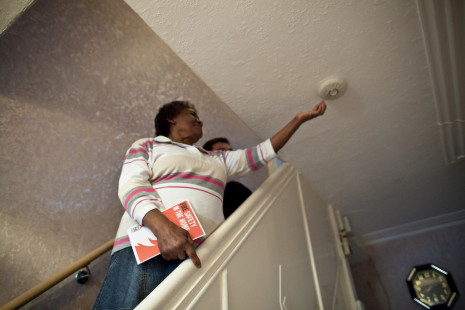How to choose, fit and test smoke alarms
The easiest way to protect yourself, your home and others from fire is with working smoke alarms. Make sure you have at least one on every level of your home and test them at least monthly. Get them. Install them. Test them. They could save your life.
Smoke alarm types
Ten-year sealed battery smoke alarms are the best option for most people. Smoke alarms with one year batteries need a new battery every year, which is easy to forget.
If you live in a large house or over several levels, you could consider mains-powered alarms (these are powered by your home power supply). They will need to be installed by a qualified electrician.
Some battery or mains-powered alarms can be interlinked so that when one alarm detects a fire they all go off together, ensuring the alarm is heard throughout the home.
If you use Telecare, you should ensure that your fire detection system is linked to your Telecare systems.
Look out for one of these symbols, which show the alarm is approved and safe:
If you do not know which smoke alarms to choose, ask your local fire and rescue service. They can help you.
Smoke alarms for people who are hard of hearing
Strobe light and vibrating-pad alarms are available for those who are deaf or hard of hearing. Contact the RNID Information Line on 0808 808 0123 or textphone 0808 808 9000.
If you do not know which smoke alarms to choose, ask your local fire and rescue service. They can advise you. Find out more about getting expert advice.
Fitting smoke alarms
Fit at least one smoke alarm on every level of your home. The ideal position is on the ceiling, in the middle of a room, and on the hallway and landing, so you can hear an alarm throughout your home and so they protect your escape routes.
For extra safety, fit smoke alarms in the bedrooms too – this can help protect you while you sleep – and in other rooms where there are fire hazards. Do not put smoke alarms in or near kitchens or bathrooms where smoke or steam can set them off by accident. Heat alarms can be placed in a kitchen so you may consider installing one there.
You could also consider installing carbon monoxide alarms, which provide protection against carbon monoxide poisoning. Carbon monoxide is a silent killer – you cannot see it, taste it or smell it so an alarm is the only way to detect it.
Testing smoke alarms
Test your smoke alarms at least monthly, no matter what type of alarm you have. Testing smoke alarms tests the smoke sensor as well as the power supply and/or battery. Test them by pressing the button until the alarm sounds. If it doesn’t sound, you need to replace the battery.
If a smoke alarm starts to beep on a regular basis, you need to replace the battery immediately. Never disconnect or take the batteries out of your alarm if it goes off by mistake. If it is a ten-year alarm, you will need to replace the alarm itself every ten years.
Replacing smoke alarms
Many smoke alarms will have an expiry date on them showing when you should replace the alarm. Replacing alarms every ten years is generally a good idea, but smoke alarms may need replacing before then, depending on how often they’re activated and the potential build-up of contaminants.
Other equipment
Other equipment you may find helpful includes:
- fire blankets, which are used to put out a fire or wrap a person whose clothes are on fire - these are best kept in the kitchen
- fire extinguishers, which shoot out a jet to help control a fire - they are quick and simple to use but you should always read the instructions first
How to protect your home from fire
How to protect your rental property from fire
How to protect a business or public building from fire
If in doubt, get out, stay out and call 999.


